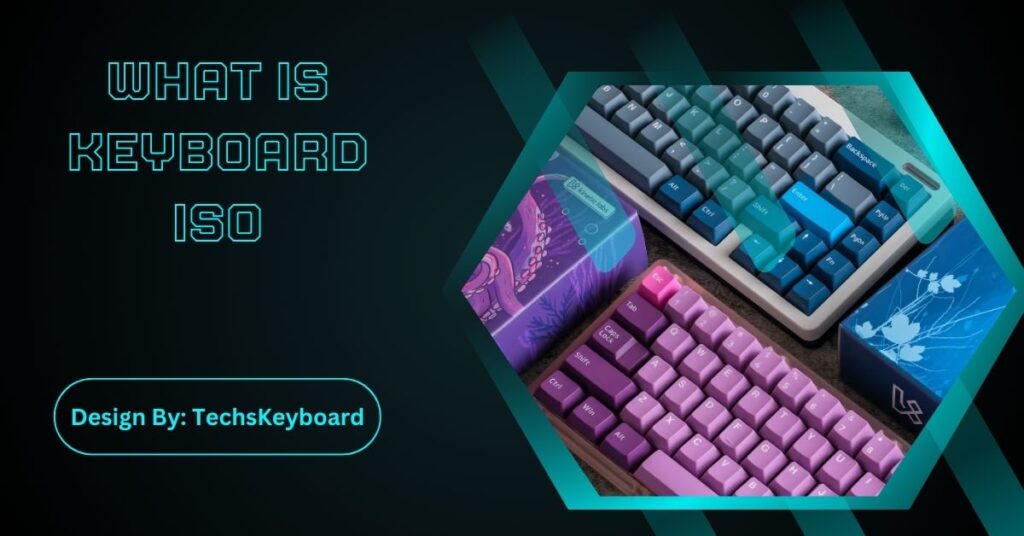Keyboard ISO is a European layout standard featuring an L-shaped Enter key, shorter left Shift key, and Alt Gr key, ideal for multilingual typing, offering compatibility with various European languages.
If you’ve explored the world of mechanical keyboards, gaming setups, or even standard office keyboards, you may have come across the term “keyboard ISO.” But what exactly does it mean—and how does it compare to other layouts like ANSI? This blog will break it all down for you.
Whether you’re choosing your next keyboard or simply want to better understand keyboard layouts, we’ve got you covered!
Understanding Keyboard ISO:

ISO, or International Organization for Standardization, is a keyboard layout standard used primarily in Europe. The ISO layout is one of the major keyboard standards (alongside ANSI and JIS) and dictates the physical layout and size of certain keys on the keyboard.
Key Features of ISO Layout
ISO keyboards have a few distinct differences that set them apart from other layouts:
Enter Key Shape
One of the most noticeable features is the L-shaped Enter key. It’s wider on the bottom row, compared to the rectangular Enter key found on ANSI keyboards.
Shift Key Size
The left Shift key is shorter than that on the ANSI layout. This allows for an additional key in its place—typically a language-related key, such as the greater-than/less-than (< >) key.
Placement of Certain Keys
- The Backslash (\) key sits directly above the Enter key.
- The Alt Gr key is standard on ISO layouts, replacing the right Alt key, providing access to additional characters often needed for European languages.
Total Number of Keys
ISO keyboards often have one additional key compared to ANSI (105 keys vs. 104 keys on full-size keyboards).
Who Uses ISO Keyboards?
ISO layouts are most commonly used in European countries, including the UK, Germany, France, and Spain. They cater to the unique language needs of these regions, such as accommodating diacritics and special characters that are not prevalent in English-speaking countries.
If you’re in the U.S. or Canada, your default keyboard setup is likely to be ANSI.
ISO vs. ANSI vs. JIS:
When discussing keyboard layouts, three main standards dominate the conversation:
ANSI (American National Standards Institute)
- Used primarily in the U.S. and Canada.
- Features a rectangular Enter key.
- Wider left Shift key compared to ISO.
- Less suited for non-English languages.
ISO (International Organization for Standardization)
- Popular in Europe.
- Includes the L-shaped Enter key and an Alt Gr key.
- Accommodates a wider range of language-specific characters.
JIS (Japanese Industrial Standard)
- Used primarily in Japan.
- Includes additional keys for switching between Japanese and English input.
- Compact key placement, catering to dual-language requirements.
Each layout serves different regions and language needs, so choosing the right one depends on your location and personal preference.
Also Read: How To Clean Macbook Keyboard – A Complete and Easy Guide!
Benefits of Keyboard ISO:
Language Compatibility
With an Alt Gr key and additional language-specific keys, ISO keyboards are perfect for users typing in European languages that use accented or special characters.
Consistency for European Users
ISO layouts are a familiar standard for many European users. Whether at work or home, using ISO provides a comfortable and consistent experience.
More Keys
Compared to ANSI, ISO layouts offer a slightly higher key count, meaning more options for customization and key mapping—especially appealing for mechanical keyboard enthusiasts.
International-Friendly
Need to switch between English and another European language? ISO keyboards streamline typing in multilingual settings with their flexibility.
Making Your Decision:

Consider these factors when deciding between ISO and ANSI keyboard layouts:
- Regional Considerations: If you live in Europe or frequently type in European languages, an ISO layout may be more suitable.
- Multilingual Typing: ISO keyboards streamline typing in multilingual settings with their flexibility, thanks to the additional characters accessible through the Alt Gr key.
- Personal Preference: If you are already accustomed to the L-shaped Enter key and shorter left Shift key, or if you prefer the aesthetics or typing style of mechanical keyboards specific to ISO layouts, it may be the right choice for you.
By understanding these differences and considering your personal needs and preferences, you can confidently choose the keyboard layout that best suits your typing experience.
When Should You Choose ISO?
Here’s when you might consider choosing an ISO keyboard layout:
- You live in Europe or frequently type in European languages.
- You need the Alt Gr key to access specialized characters.
- You are already accustomed to the L-shaped Enter key and shorter left Shift key.
- You’re into mechanical keyboards and want a layout specific to your typing style or aesthetics.
If none of the points above apply to you, ANSI might still be the better choice for your typing setup—especially if you’re based in North America.
Common Questions About Keyboard ISO:
1. Can I use an ISO keyboard in the U.S.?
Absolutely! While the ISO layout is less common in North America, it’s fully compatible with U.S. systems. However, you might need to adjust keyboard settings in your operating system.
2. Can I switch between ISO and ANSI layouts easily?
Switching between layouts may feel unnatural at first, especially due to the different positions and sizes of the Enter and Shift keys. But with practice, you can adapt to either layout.
3. What are some popular brands offering ISO keyboards?
Many top keyboard brands, such as Cherry, Logitech, and Razer, offer ISO-compatible models tailored to European markets.
4. Is ISO better than ANSI?
Neither is objectively better—it depends on your region and language preferences. ANSI tends to be better for English-only setups, while ISO shines in multilingual environments.
5. Can I use keycaps made for ANSI on an ISO keyboard?
Not directly. ANSI and ISO layouts have different key sizes, so keycaps designed for one may not fit the other correctly.
Conclusion:
In conclusion, the choice between ISO and ANSI keyboard layouts ultimately boils down to personal preference, regional standards, and language requirements. Both layouts have their merits and are fully functional in their respective regions. Whether you prefer the familiarity of the ANSI layout or the multilingual capabilities of the ISO layout, the key is to find a keyboard that suits your needs and typing style. So, embrace the layout that empowers you to maximize your productivity, comfort, and enjoyment in every keystroke.


